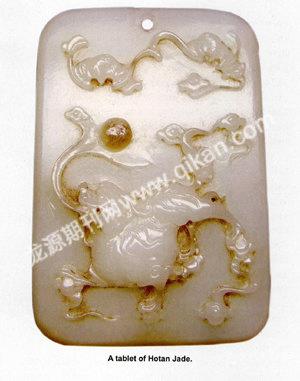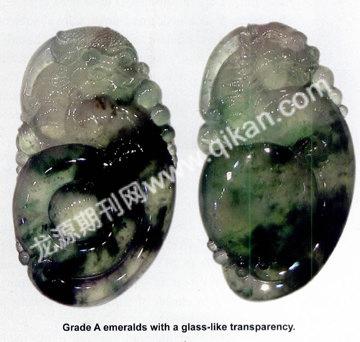Fabulous Dragon Stone
By staff reporter WU BING

THERE is a Chinese saying, “Gold is expensive but jade is priceless.” In other words, gold represents wealth and jade elegance. Gold inlaid with jade traditionally symbolizes happy marriage. This precious combination in the 2008 Beijing Olympic Games medal design conveys the host citys respect for the games and best wishes to Olympic athletes.
Jade Worth 15 Cities
Depleted raw materials and rising market demand over past decades have sent jade prices sky-high. First-class Hotan white jade could be bought in the late 1970s for RMB 100 per kg. By 1995 this price had rocketed to RMB 6,000, and by 2000 soared to RMB 10,000. Its current price is RMB one million per kg. The upward trend in the jade market still continues. But this opulence is dwarfed by the even more precious Myanmar Jade, which sells at 10-100 times the price of white jade.
Jade has been treasured in China for more than 7,000 years, and often features in historical legends. One, during the Spring and Autumn Period (770-476 BC), tells of a jade craftsman named Bian He from the State of Chu. One day he saw a phoenix perching on a rock. Convinced that this fabulous bird would stand only on the most precious of stones, he presented the rock to King Li of Chu. Royal craftsman, however, assessed it as nothing out of the ordinary. The angry king punished Bian He for what he construed as an attempt to fool him by having the craftsmans left foot cut off. When King Li died, Bian He once again presented the stone to the kings son and successor King Wu. But the new kings craftsman also deemed the stone commonplace, and Bian He lost his right foot as punishment. When King Wu died and his son succeeded the throne as King Wen, Bian He retreated to the foot of the mountain and cried for three days and nights, holding the stone. When the new king sent his attendant to find out why, Bian He told him, “I cry not because I have been crippled, but because jade is deemed stone, a loyal subject is adjudged a charlatan, and an innocent is humiliated.” King Wen thereupon ordered that the stone be split open. The piece of perfect jade exposed at its heart was named Hes Jade.
Many vassal states fought over the precious Hes Jade, and the State of Zhao eventually won possession of it. The rising Qin kingdom, however, offered to trade 15 cities for the jade in 283 BC, and Zhao agreed, but mainly for fear of the Qins overwhelming strength. “As worthy as a cluster of cities” hence became a common idiom.

Qin craftsmen carved an imperial seal out of the jade which the last Qin emperor presented to the conqueror Liu Bang, first emperor of the Han Dynasty (206 BC - AD 220). Amid the imperial infighting at the end of the Han Dynasty, a corner of the seal was broken. Craftsmen later mended it in gold, thus creating the craft of jade and gold inlay, the Beijing Olympics medal design.
The Five Virtues of Jade
There are around 100 types of stones that qualify as jade. According to Shuo Wen Jie Zi (Explanation and Study of Principles of Composition of Characters), the earliest Chinese dictionary compiled by Xu Shen during the Eastern Han Dynasty (25-220), “Jade, the beauty among stones, embodies five virtues.” In other words, the only beautiful stones that may be called jade are those with five virtues. But criteria on which to judge whether or not a stone is beautiful, or beautiful enough to be called a jade, have changed with the development of society, production capacities, ideologies and aesthestic standards, and market demands. Stones formerly used for burning lime, laying roads or building houses now qualify as jade by virtue of their fine texture or historical background.

Uncut jade can be polished or processed to bring it up to a satisfactory standard. Gradation is linked to the degree of processing. A Grade-A emerald, for example, is one that has been cut, carved and polished but whose color and innate substance remain unaltered. An emerald that has been washed in acid or alkali and reconstituted with synthetic resin is of Grade B, specifically classified in the market as a washed or bathed emerald “after bleaching and reconstitution.” Dyed emeralds are Grade C, known as coated or clothed emeralds. Evaluation standards include color, transparency, structure, purity, cutting workmanship and weight.
The Chinese character for emerald, feicui, is the same as that for kingfishers, the red male called fei and the green female the cui. Natural emeralds are also either green or red, hence their Chinese name. Emeralds came into Chinese favor in the late Ming and early Qing dynasties, when they suddenly became regarded as the finest of all jade.
The Confucian school highly commends the five virtues of jades, comparing them with the five virtues of the “true man.” The luster of jade symbolizes benevolence, its transparency justice, its tone wisdom, its solidity courage, and its whorled fractures honesty and self-restraint. Those who love jade should be “true men” and confine their behavior according to the five virtues.
Everyday Jade
Jade was a predominant feature of old Chinese society, as apparent in decorative articles, household utensils, and sacrificial vessels in well-to-do homes.

Accessory jades were particularly popular, as in addition to its moral connotations, jade was also believed to be a powerful amulet. The customs of millennia became fashionable in the Ming (1368-1644) and Qing (1644-1911) dynasties, particularly in the Ming when jade became a feature of the court dress. That worn by the emperor, empress, other members of the royal family and court officials denoted rank. Ming Dynasty jade accessories extant are mainly jade belts and hooks. During Qing times there was a wider scope that included sachets, flat hairpins, knuckle shields and belt hooks. The knuckle shield, originally a crossbow accessory, hooked on to the thumb. The most popular styles featured double-fish, heart or animal designs. Jade ornaments today are generally in the form of jewelry, such as bracelets and pendants.
Hotan Jade and emeralds are most desirable in the current market, closely followed by Xiuyan Jade, Dushan Jade, lazurite and turquoise. Hotan Jade takes its name from its place of origin – Hotan in Xinjiang Uygur Autonomous Region, but is also found in Qinghai, Sichuan, Liaoning, Gansu and Taiwan provinces, as well as in Russia, Poland, Germany, the U.S., Canada and New Zealand. The best outside China is found in Russia.
The features that best distinguish Hotan Jade are its color and texture. There are white, green, blue, black, yellow, brown and flowery jades. The smoothest and most transparent is white jade, also called suet white jade. Hotan Jade is in huge demand on the market, but excessive exploitation threatens its continued supply.

